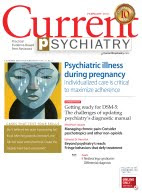Ervin Davis, PhD, Assistant professor, Department of psychology, Adjunct assistant professor of psychiatry, Department of psychiatric medicine, Brody School of Medicine at East Carolina University, Greenville, NC
Richard M. Bloch, PhD, Professor and director of research, Department of psychiatric medicine, Brody School of Medicine at East Carolina University, Greenville, NC
Crystal Manuel, MD, Assistant professor, Department of psychiatric medicine, Brody School of Medicine at East Carolina University, Greenville, NC
Sy Atezaz Saeed, MD, Professor and chair, Department of psychiatric medicine, Brody School of Medicine at East Carolina University, Greenville, NC
The number of people with psychiatric disorders who use complementary and alternative medicine (CAM) is on the rise. In surveys of patients seeking psychiatric care, estimates of CAM use range from 8% to 57%; the most frequent uses are for depression and anxiety disorders. A population-based study in the United States found that 9% of respondents had anxiety attacks and 57% of these individuals had used CAM. Similarly, in a Finnish population-based study (N=5,987) 35% of subjects reported some form of CAM use in the previous year; those with comorbid anxiety and depressive disorders used CAM most frequently.
Unfortunately, a MEDLINE search shows that the number of studies examining psychotropic medications dwarfs the number of studies on even the most common CAM treatments used for psychiatric disorders. Far more patients with diagnosed mental disorders are studied in trials of standard treatments than CAM treatments. Because very few studies evaluate the cost-effectiveness of CAM treatments for psychiatric disorders, the risk-to-benefit ratio is difficult to calculate. Although several CAM treatments for depressive disorders have enough support to be considered options, CAM options for anxiety disorders are fewer and have less evidence of efficacy.


Dr. Nasrallah,
ReplyDeleteThe problem with all your questions is that you are disregarding the most important aspect of psychotherapy: it treats the individual, the person, and not the arbitrary entities that psychiatry has constructed with its diagnostic systems. Your approach is very mechanistic and all it can do is to dissect in innumerable parts a subject matter. It is suited for understanding machines but it is not suited to understand living beings in their unity. The objective result of all your questions is to destroy psychotherapy and not to further it. Why you can't just let people decide what psychotherapy they want, and with whom, and how often? Why the use of psychotherapy should be justified? To whom? Maybe is because somebody else will pay? Why don't let individuals pay for their own psychotherapy and let third parties out of the picture? This is indeed the crux of the problem. You probably feel very uncomfortable with the idea of having people decide.
Francesco Martino, MD